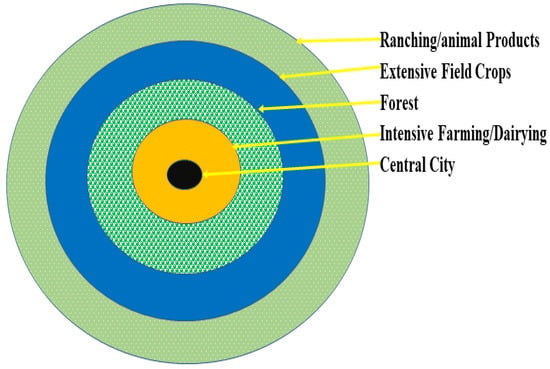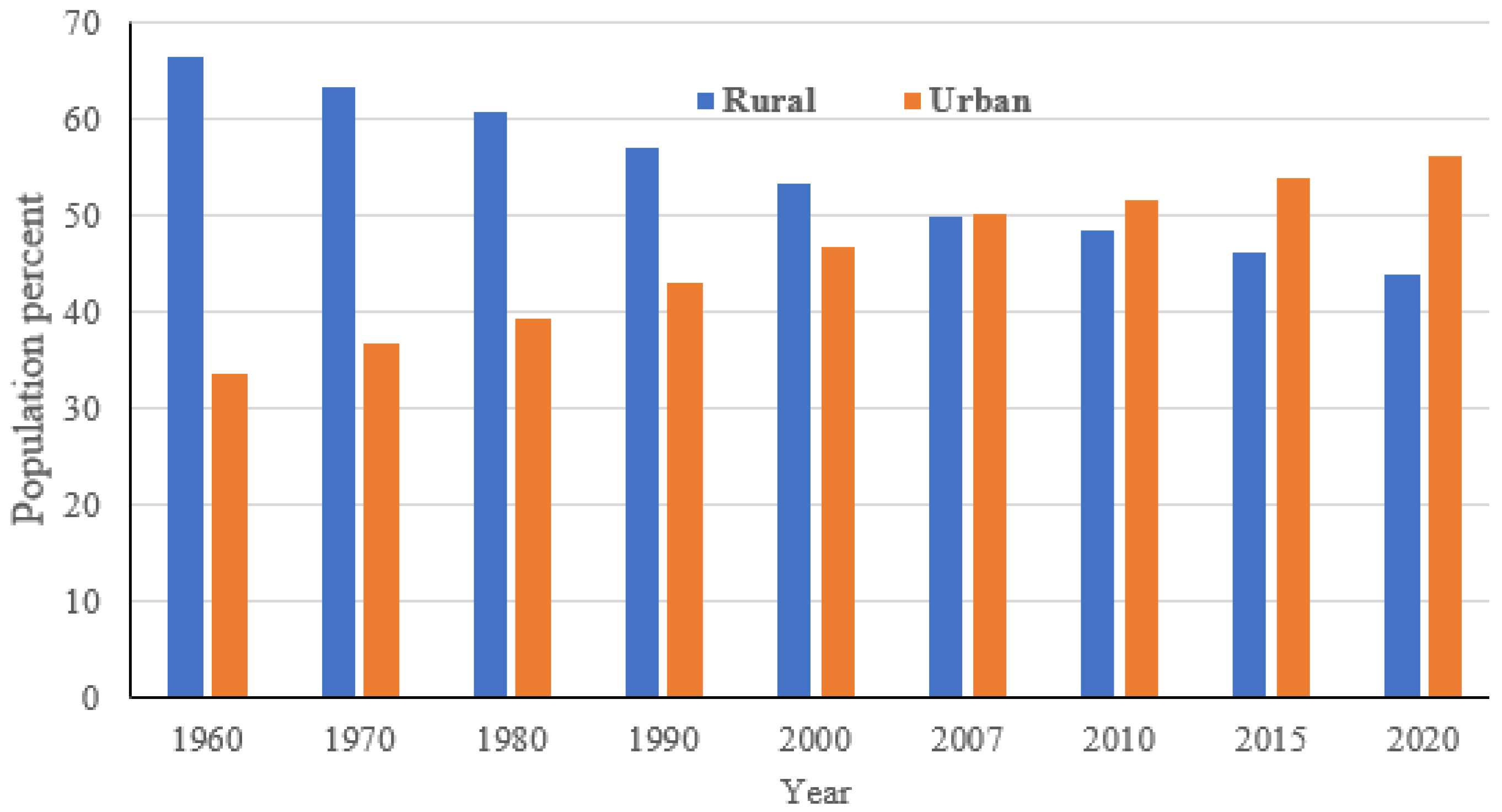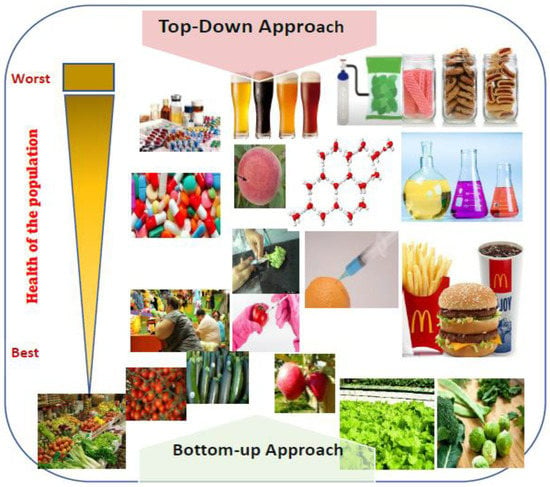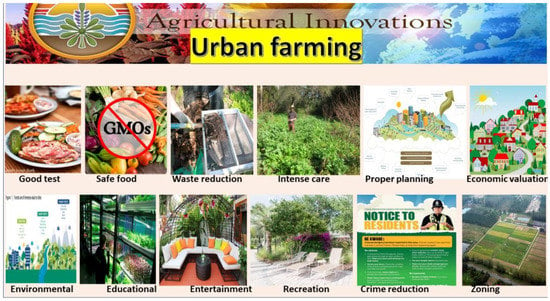1. Introduction
City residents have practiced urban farming for centuries. In recent years, there has been a resurgence of interest in it because of concerns about urban food access, sustainability, and food security. Due to its potential to support food security and sustainable agriculture, and because of its lesser impact on the environment than conventional agricultural practices, urban farming is becoming more attractive than before. A Michigan State University study has found that traditionally produced food in the USA is transported by an average distance of almost 1500 miles before it arrives on supermarket shelves
[1]. This has many implications, including the unnecessary extra cost of food, increased carbon emission, deterioration of freshness of food, and potential for supply disruption due to inclement weather, pandemics, road closures, strikes, and other causes. For an industrial market economy, such a supply chain is necessary at the present time. However, the practice of urban agriculture can help avoid some of these problems, while also generating part-time jobs.
Urban agriculture attempts to advance sustainable agricultural methods, such as composting, the use of organic fertilizers, and water conservation. It involves a multidisciplinary approach, combining knowledge of soil science, plant physiology, sustainable agriculture, and technology. Crop rotation and companion planting are two other methods urban farmers can utilize to lessen the demand for pesticides and herbicides. The crops are managed using advanced technology involving sensor-based monitoring, automated irrigation systems, and data analysis to maximize crop output. Urban crop farming is regarded as an important agricultural activity for the modern and circular economy, as it can also improve the urban residents’ income and reduce agricultural waste.
Of the eight billion people on earth in 2023, more than 55% are already living in urban areas
[2] (Ritchie and Roser 2018). Agriculture has been a significant source of food, income, and employment, and it can also help to reduce poverty, increase income levels, and promote prosperity for a projected 9.7 billion people by 2050
[3][4]. The urban population is expected to exceed 75% of the total global population by 2050, making urban agriculture even more important. In light of several persistent issues, such as climate change, greenhouse gas emissions, pollution and waste generation, food shortage, and food waste, agricultural growth through traditional farming is constantly in danger
[3]. Weed growth, which annually results in major crop loss, is another serious issue that traditional farmers must contend with
[4][5][6]. Agriculture contributed almost 4% to the global Gross Domestic Product (GDP) in 2018, and it makes up more than 25% of the GDP in some developing nations. Despite the extensive traditional farming, about 9% of the world’s population remained hungry in 2020
[3][6].
Theoretically, to feed the growing population, a cultivation area equal to that of the South American continent is needed. In addition, a farming area consisting of almost the size of the African continent is needed for all the animals that are essential to support human activities. This will require bringing almost 57% of the total earth’s surface under habitation. However, as almost 57% of the earth’s land surface is unhabitable, all human activities must be limited to 43% of the total land surface. Within that 43% area, all types of land use, such as forest, built-up areas, infrastructure, agriculture, water bodies, and various recreational activities, must be accommodated. Currently, of the global land surface, urban areas occupy between one and 3% of the total land area. Concentrating the urban population that would reach 75% of the total global population by 2050 within the urban areas means that urban planning must become smarter than it is today, and that includes the practice of urban agriculture
[2].
The traditional agricultural sector has become a polluting, water-intense, and ecologically damaging industry. Urban agriculture (or farming) could help to offset some of these problems by shifting at least part of the agricultural production to the urban farms. Urban farmers must comprehend how plants grow. This involves being aware of how light, temperature, and water affect plant growth
[7] and knowing how to spot and deal with pests and diseases that could harm plants. Moreover, it is important to know how using nutrient-rich water instead of soil, as with hydroponics, can help plants grow. This method is particularly helpful in urban settings with limited space for farming and generally poor soil conditions. Understanding plant nutrient needs, water chemistry, and environmental controls is necessary for hydroponic farming systems. To limit their production within smaller spaces, urban farmers frequently adopt clever methods such as vertical farming, rooftops, balconies, and communal gardens. To create the optimum plant-growing conditions, farmers need to amend the soil with fertilizers, check for impurities, and keep an eye on the pH (potential for hydrogen) level of the soil. Urban farmers need to control pests without resorting to hazardous chemicals that could endanger either human health or the environment. This could entail utilizing organic pest management techniques, such as companion planting, or the introduction of beneficial insects.
2. Theory of Urban Farming
The first settlements on the earth started in areas with fertile plains. Such settlements later emerged as urban centers, where people from peri-urban areas and remote villages used to have farmers’ markets organized on a regular basis. However, those traditions were not enough to meet the requirements of a large urban population. After the harvest, many agricultural products quickly perished, and they needed to be transported to the consumption sites quickly. Since there were no good transportation networks, many of the products decayed during their long transit. To solve this problem, a German economist and agriculture planner, J. H. Von Thunen (1783–1850), in 1826, using the example of Chicago, argued that city farming should be located centrally within an “Isolated State” (Figure 1).
Figure 1. Von Thunen model of land use. (Adapted and modified from
[8]).
The Von Thunen model developed a theory of marginal productivity by assuming a uniform land surface without any undulation. Land may be rented to grow crops and transported to different households on an oxcart. The cost of any agricultural products would involve the land rent and transportation cost, as given by Equation (1):
Since the typical isolated state was surrounded by “unoccupied wilderness”, especially in a place of food desert, farmers needed to grow agricultural crops and dairy products in the nearby urban areas because agricultural products would perish while being ferried from the production site to the distant urban centers. This was before refrigerated trucks were developed. Farmers largely grew their own food, such as dairy products, fruits, vegetables, eggs, and meat, and consumed it fresh. However, the situation has changed in the last several decades with the development of trucks with refrigerated containers. The long-distance hauling facilities offered by such trucks have made it possible to transport perishable food products over long distances, with less damage to the food. However, the long-distance food transportation process can cause several environmental problems.
First, transporting food increases emissions of various toxic and greenhouse gases. Additionally, the packing and unpacking of food have increased the use of plastic, tin, metal, and paper. The production of these materials contributes 14 to 17% of global anthropogenic emissions
[9]. The production, packaging, storage, and transportation of agricultural farm products contribute additional greenhouse gas emission (GHG), which, at present, accounts for 3 to 6% of the total emissions globally
[10].
Second, when food is transported over long distances, a significant portion of that food is still wasted. Globally, one-third of all the food produced is wasted, with almost 1.6 billion tons of food being spoiled on the way to the market or date-expired during storage and simply thrown away
[11]. Every year, over 600 million people get sick from eating contaminated food
[12]. Additionally, long hauling also increases the cost of food. The supply chain can be disrupted for many reasons, such as labor issues, road conditions, inclement weather, the availability of fuel, political unrest, and pandemics, such as COVID-19.
It is useful to capture atmospheric carbon by using carbon sequestration in urban areas too, i.e., trapping carbon by plants to convert it into plant food, biomass, and fruits. Plants can sequester carbon and increase net primary productivity (NPP) per unit area, eventually increasing the gross primary productivity (GPP)
[13] of an urban area. Atmospheric carbon can be stored on plant bodies that contribute to plant growth. For instance, a 0.4 carbon use efficiency (CUE) indicates that 40% of the carbon acquired by plants is taken up for the growth and storage of biomass. The CUE of a plant can be measured through biomass
[14][15], and the total growth of a plant over an urban area can be converted into GPP
[16]. It provides a better understanding of the energy exchange between vegetation and the atmosphere by estimating the CUE of a plant and vegetation carbon dynamics (VCD). A phytotherapy process helps to trap many anthropogenic drivers originating from different sources in the urban environment. These analyses shed some light on the rate of carbon allocation and help to accurately quantify the ability of vegetation to convert carbon to new biomass in urban ecosystems. Furthermore, the CUE assessment would provide new insights into vegetation carbon allocation at regional and global scales. An accurate quantification of CUE for various vegetation types would enhance the performance of earth-system-related models. Since urban farming is performed on a smaller scale, it helps to precisely quantify the CUE and assess the VCD for an urban area. The VCD is a measure of the rapid increase in the atmospheric concentration of CO
2 and other greenhouse gases. Assessing the VCD can help to measure the productivity of various plants
[17].
Of the global terrestrial land surface, 71% is habitable. Of the 71%, 33% is arable, and 1% is under urban land uses
[18]. A major portion of the population is living in smaller urban areas. Since 2007, the percentage of the urban population (50.14%) has exceeded the rural population (49.86%) (
Figure 2)
[19]. As the urban population increases, many people have to concentrate their activities in even smaller areas that are urban.
Figure 2. Global rural and urban population percentages (1960–2020)
[19].
The rapid growth of urban population has increased food insecurity in cities, and it has overstretched the supply chain, especially at the time of crises such as the COVID-19 pandemic. The United Nations Food and Agriculture Organization (FAO)
[20] predicts that, compared to 2022, the global food demand will increase by 70% by 2050. This will put pressure on the already scarce land and water resources. This also means that there is an urgent need for a supplemental approach to address possible urban food shortages.
Urban agriculture has the potential to provide safe and easy access to food for hundreds of millions of people. Urban farming is a way to utilize limited land resources to produce food within urban and peri-urban areas and supply it in response to the daily demand of consumers within a town/city. It applies intensive production methods, using and reusing natural resources and organic urban wastes to yield a diversity of crops and livestock to meet urban food needs. Urban farming offers easy access to fresh and nutritious food. This process was officially recognized by the 15th FAO meeting in January 1999 and subsequently at the World Food Summit in 2002. Since then, its importance has been even more appreciated because, like other service sectors and industries, urban farming provides additional employment and income opportunities for the urbanites. Urban agriculture can create a diverse ecology where fruit trees and vegetables and even fishing could coexist and build an ecologically sustainable circular economy.
Since only small land areas are available for farming in the cities, urban farming is often performed on top of hardscape (pavements, sidewalks, rooftops, and balconies). However, only shallow rooting plants can be planted on raised beds on hardscape. In such a hardscape, if animal manure and chemical fertilizers are used, they generate additional greenhouse gases. However, if organic compost is used, it helps sequester atmospheric carbon within the compost and plant bodies, while using 70 less water. In a smaller area, vertical farming is possible by using compost, wherein every layer can sequester carbon.
Other forms of urban farming on hardscapes include hydroponics, rooftop and balcony, backyard and front yard farming, community gardens, farming in the park, and parking-lot farming. Except for hydroponics, compost made from the by-products of various vegetables and other food products can be used in all types of farming that can not only efficiently sequester carbon but also become a healthy practice because all the products are produced locally and bottom-up, as opposed to a top-down approach (Figure 3). If the urban area has open green spaces, animal manure can be used on the ground. Planting on the open ground allows deep-rooted trees to sequester carbon at a deeper level. In such an environment, the use of animal manure and chemical fertilizers contributes less GHS because most of the carbon is sent back to deeper soil through the deep root system.
Figure 3. Urban farming: A bottom-up approach, as opposed to a top-down conventional approach, to food production and acquisition. Conceptualized and drawn by the authors, using some generic images from the web.
There are several benefits of urban farming. Some of the major benefits include but are not limited to (a) the better taste of vegetable and fruit products; (b) the fact that these are organic and not the genetically modified (GMO) varieties; (c) the use and reuse of wastes; (d) through carbon use efficiency (CPU) and vegetation carbon dynamics (VCD), the net primary productivity (NPP) and overall gross vegetation product (GPP) improve; (e) communities are united through the close monitoring of the production system; (f) educational exhibition; and (g) crime reduction through the involvement of unemployed youths in some creative activities (Figure 4).
Figure 4. Benefits of urban farming. Graphics showing some benefits of locally produced food in urban areas. Conceptualized and drawn by the authors, using some generic images from the web.









